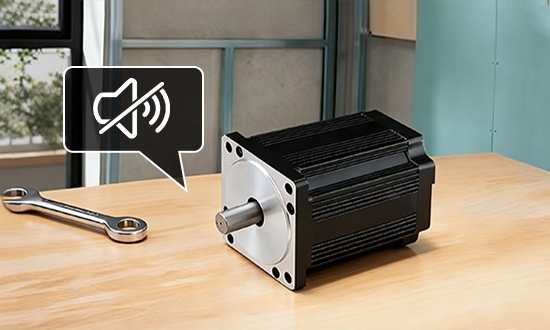Brushless DC motors are widely used in industries, home appliances, robotics, and electric transportation due to their high efficiency, long lifespan, and low maintenance requirements. However, despite their many advantages, BLDC motors can generate noise during operation, which can affect both the working environment and the motor’s performance. Therefore, noise reduction in BLDC motors has become an important topic in motor design and usage.
In this article, we will explore effective brushless motor noise reduction techniques to help engineers and designers optimize motor performance and enhance user experience.

1. Optimize Motor Design: Reducing Mechanical Noise
The noise in BLDC motors mainly comes from mechanical vibrations, electromagnetic field changes, and airflow. By optimizing the motor design, we can effectively reduce these sources of noise.
- Improve Rotor and Stator Alignment: The gap between the rotor and stator directly affects motor noise. If the gap is too large, vibrations during operation can lead to noise. By ensuring precise manufacturing and a tighter rotor-to-stator fit, mechanical noise can be significantly reduced.
- Use High-Quality Bearings: Bearings play a crucial role in the operation of a motor. Poor-quality bearings can generate frictional noise. Choosing high-quality, low-noise bearings and optimizing lubrication can greatly reduce the noise caused by bearings.
2. Motor Control Strategies: Smooth Torque and Speed Output
Another key factor contributing to brushless electric motor noise is fluctuations in speed and torque. By adopting more sophisticated control strategies in BLDC controllers, we can make the motor run more smoothly, which in turn reduces noise.
- Field-Oriented Control (FOC): FOC is an efficient motor control method used in BLDC controllers that precisely controls current and voltage to optimize torque output. This reduces noise caused by torque fluctuations, providing a smoother, quieter operation.
- Pulse Width Modulation (PWM) Technology: PWM is a common control technique employed by BLDC controllers. By adjusting the PWM signal frequency, these controllers can control motor speed and reduce low-frequency noise. Higher PWM frequencies lead to quieter motor operation.
3. Material Selection and Optimization
The materials used in the motor also directly impact its noise levels. High-quality materials not only improve motor efficiency but also reduce noise.
- Optimize Magnetic Materials: Using high-performance permanent magnets, such as rare-earth materials (neodymium iron boron magnets), can reduce electromagnetic noise during motor operation. Carefully selecting and arranging the magnetic materials helps reduce the generation of electromagnetic noise.
- Use Noise-Dampening Materials: Incorporating noise-dampening materials in the motor casing and internal components (such as vibration pads and sound-absorbing foam) can effectively reduce the noise caused by motor vibrations. This is particularly important in applications like home appliances and noise-sensitive environments.
4. Optimizing External Motor Structure
The external structure of the motor and its materials also affect how noise propagates. A well-designed external structure can not only improve the motor's efficiency but also isolate noise effectively.
- Optimize Fan Design: BLDC electric motors often require cooling at high loads, and the design of the cooling fan is crucial. Optimizing the fan blade shape, number, and angle can reduce fan-induced noise. Using quiet fans or reducing the frequency of fan usage can significantly lower noise levels.
- Improve Casing Structure: The design of the motor casing can also influence noise transmission. Using thicker, more sealed casing materials can help contain the noise. Additionally, the shape and structure of the casing can be optimized to reduce airflow-related noise.
5. Optimizing the Motor Operating Environment
In addition to the motor design and materials, the environment in which the motor operates can also impact noise levels. By optimizing the installation environment, further noise reduction can be achieved.
- Vibration Isolation: Installing the motor on vibration isolation mounts can significantly reduce noise caused by vibrations. In industrial environments, using soundproof enclosures or placing the motor in soundproof rooms can reduce noise propagation.
- Optimize Airflow: Improving airflow around the motor can help reduce noise generated by the fan and cooling system. Ensuring that air flows freely without obstruction also contributes to better cooling and less noise.
Conclusion
Motor noise is a complex challenge that involves design, control strategies, materials, and operating conditions. By optimizing motor design, using high-quality materials, adopting advanced control technologies, and improving the motor’s operating environment, significant noise reduction can be achieved. This not only improves motor performance but also enhances user experience, especially in noise-sensitive applications.
With the continuous development of motor technologies, the application of BLDC motors will only expand, and quieter, more efficient motors will become the standard for future innovations. We hope this article provides valuable insights into brushless motor noise reduction techniques and helps you design quieter, more efficient motors for your applications.
